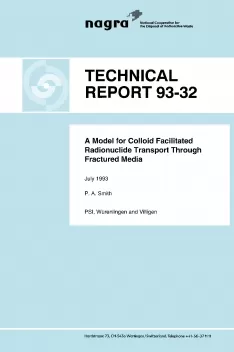
Technical Report NTB 93-32
A Model for Colloid Facilitated Radionuclide Transport Through Fractured Media
In the safety assessment of nuclear waste repositories, sorption of radionuclides on the surfaces of colloids may significantly modify transport behaviour where colloid concentration is sufficiently high. In the case of fractured geological media, colloids may be excluded from matrix pores, in which case radionuclides bound to them are not subject to the retarding effects of matrix diffusion and sorption onto matrix pore surfaces.
A transport model is presented describing colloid facilitated transport through fractured media with non-linear sorption. A simplified model, with linear sorption both on pore surfaces and colloids, is derived from the more general model. Such a model is desirable if it can be demonstrated to be conservative. However, even when the same sorption mechanism is known to operate for pore surfaces and colloids, it is unclear how the same linear model for sorption can be applied conservatively to both, since low sorption onto pore surfaces is conservative, while a high degree of sorption on colloids is also conservative.
The question of whether the use of the simplified model, with a linear sorption coefficient, calculated for the highest concentration encountered along the flow path, is conservative for colloid facilitated transport is addressed and simple criteria are developed to predict when the presence of colloids will have a significant influence on transport. A series of simulations using the more general model is carried out, illustrating the general behavior to be expected and effects resulting from the non-linearity of sorption are described.
